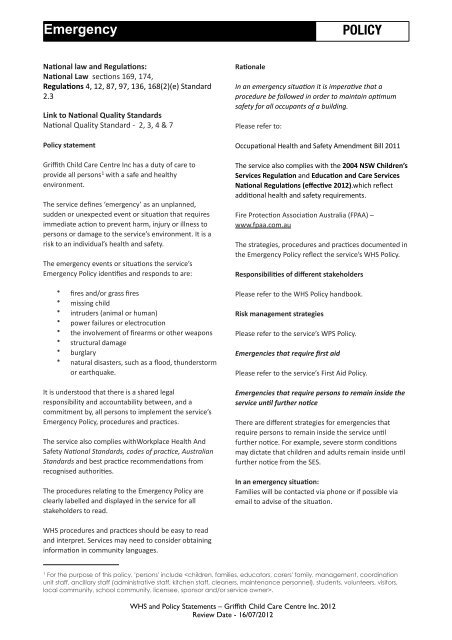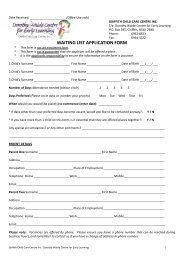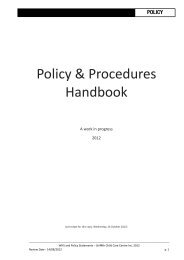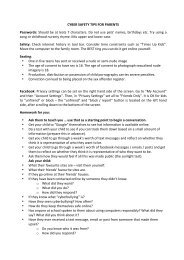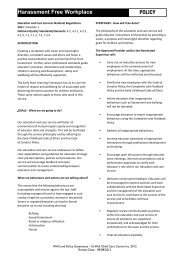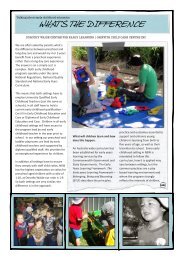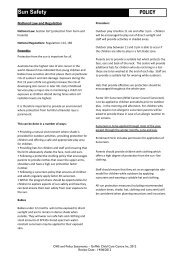Emergency and Evacuation Policy - Dorothy Waide Centre for Early ...
Emergency and Evacuation Policy - Dorothy Waide Centre for Early ...
Emergency and Evacuation Policy - Dorothy Waide Centre for Early ...
Create successful ePaper yourself
Turn your PDF publications into a flip-book with our unique Google optimized e-Paper software.
<strong>Emergency</strong><br />
POLICY<br />
Na#onal law <strong>and</strong> Regula#ons:<br />
Na#onal Law sec%ons 169, 174, <br />
Regula#ons 4, 12, 87, 97, 136, 168(2)(e) St<strong>and</strong>ard <br />
2.3<br />
Link to Na#onal Quality St<strong>and</strong>ards <br />
Na%onal Quality St<strong>and</strong>ard -‐ 2, 3, 4 & 7<br />
<strong>Policy</strong> statement<br />
Griffith Child Care <strong>Centre</strong> Inc has a duty of care to <br />
provide all persons 1 with a safe <strong>and</strong> healthy <br />
environment. <br />
The service defines ‘emergency’ as an unplanned, <br />
sudden or unexpected event or situa%on that requires <br />
immediate ac%on to prevent harm, injury or illness to <br />
persons or damage to the service’s environment. It is a <br />
risk to an individual’s health <strong>and</strong> safety.<br />
The emergency events or situa%ons the service’s <br />
<strong>Emergency</strong> <strong>Policy</strong> iden%fies <strong>and</strong> responds to are:<br />
• fires <strong>and</strong>/or grass fires<br />
• missing child<br />
• intruders (animal or human)<br />
• power failures or electrocu%on<br />
• the involvement of firearms or other weapons<br />
• structural damage<br />
• burglary <br />
• natural disasters, such as a flood, thunderstorm <br />
or earthquake.<br />
It is understood that there is a shared legal <br />
responsibility <strong>and</strong> accountability between, <strong>and</strong> a <br />
commitment by, all persons to implement the service’s <br />
<strong>Emergency</strong> <strong>Policy</strong>, procedures <strong>and</strong> prac%ces.<br />
The service also complies withWorkplace Health And <br />
Safety Na#onal St<strong>and</strong>ards, codes of prac#ce, Australian <br />
St<strong>and</strong>ards <strong>and</strong> best prac%ce recommenda%ons from <br />
recognised authori%es.<br />
The procedures rela%ng to the <strong>Emergency</strong> <strong>Policy</strong> are <br />
clearly labelled <strong>and</strong> displayed in the service <strong>for</strong> all <br />
stakeholders to read.<br />
Ra#onale<br />
In an emergency situa#on it is impera#ve that a <br />
procedure be followed in order to maintain op#mum <br />
safety <strong>for</strong> all occupants of a building.<br />
Please refer to:<br />
Occupa%onal Health <strong>and</strong> Safety Amendment Bill 2011<br />
The service also complies with the 2004 NSW Children’s <br />
Services Regula#on <strong>and</strong> Educa#on <strong>and</strong> Care Services <br />
Na#onal Regula#ons (effec#ve 2012).which reflect <br />
addi%onal health <strong>and</strong> safety requirements.<br />
Fire Protec%on Associa%on Australia (FPAA) – <br />
www.fpaa.com.au<br />
The strategies, procedures <strong>and</strong> prac%ces documented in <br />
the <strong>Emergency</strong> <strong>Policy</strong> reflect the service’s WHS <strong>Policy</strong>.<br />
Responsibili#es of different stakeholders<br />
Please refer to the WHS <strong>Policy</strong> h<strong>and</strong>book.<br />
Risk management strategies<br />
Please refer to the service’s WPS <strong>Policy</strong>.<br />
Emergencies that require first aid<br />
Please refer to the service’s First Aid <strong>Policy</strong>.<br />
Emergencies that require persons to remain inside the <br />
service un5l further no5ce<br />
There are different strategies <strong>for</strong> emergencies that <br />
require persons to remain inside the service un%l <br />
further no%ce. For example, severe storm condi%ons <br />
may dictate that children <strong>and</strong> adults remain inside un%l <br />
further no%ce from the SES. <br />
In an emergency situa#on:<br />
Families will be contacted via phone or if possible via <br />
email to advise of the situa%on.<br />
WHS procedures <strong>and</strong> prac%ces should be easy to read <br />
<strong>and</strong> interpret. Services may need to consider obtaining <br />
in<strong>for</strong>ma%on in community languages.<br />
1<br />
For the purpose of this policy, 'persons' include
<strong>Emergency</strong><br />
POLICY<br />
Evacua5on drills<br />
Evacua%on drills are to be conducted regularly. A staff <br />
member is to take responsibility <strong>for</strong> arranging <strong>and</strong> <br />
documen%ng the evacua%on procedure.<br />
An evacua%on drill report should be completed at the <br />
end of each drill.<br />
Drills should be r<strong>and</strong>om, on different days, %mes, <br />
loca%ons <strong>and</strong> should involve different scenarios where <br />
possible -‐ eg fire, storm, dust storm, intruder etc.<br />
Documen#ng WHS procedures <strong>and</strong> prac#ces<br />
Refer to WHS {<strong>Policy</strong> Documents in conjunc%on with <br />
this policy.<br />
Dealing with the emo#onal <strong>and</strong> psychological impact <br />
of an emergency<br />
Emergencies involve more than a physical response to <br />
an unexpected or sudden event or situa%on. They have <br />
an emo%onal <strong>and</strong> psychological impact on people, <br />
which can affect individuals <strong>for</strong> an extended period afer <br />
the emergency.<br />
Play <strong>and</strong> learning experiences should be planned which <br />
encourage children to express their thoughts, feelings <br />
<strong>and</strong> emo%ons regarding an emergency.<br />
In<strong>for</strong>ma%on is to be provided <strong>for</strong> educators <strong>and</strong> families <br />
on support networks <strong>and</strong> counselling services available <br />
<strong>for</strong> children, families <strong>and</strong> educators following an <br />
emergency.<br />
Dealing with the media<br />
In an emergency, or when an incident has occurred, <br />
Media may want to seek comment or “cover” the story.<br />
Only authorised people within the organisa%on are <br />
permijed to discuss incidents with the media.<br />
Care should be taken by all staff when talking outside of <br />
the service, about incidents that have taken place, <br />
conflict could arise over privacy or other factors. <br />
Communica#on with different stakeholders<br />
Children<br />
Children are to be given opportuni%es to discuss <strong>and</strong> <br />
prac%ce emergency evacua%on procedures -‐ including <br />
evacua%on from the building in case of fire. This should <br />
happen on a regular basis <strong>and</strong> adhere to current <br />
guidelines on safe evacua%on -‐ eg “drop <strong>and</strong> roll” “Get <br />
down low <strong>and</strong> go go go”.<br />
Families<br />
Families are to be advised of safety drills <strong>and</strong> what has <br />
been discussed with children.<br />
In<strong>for</strong>ma%on on safety at home is to be provided through <br />
brochures, web-‐links <strong>and</strong> newslejers.<br />
Links to other policies<br />
This policy should be read in conjunc%on with the <br />
following policies documents <strong>and</strong> procedures:<br />
• Child protec%on <br />
• First aid<br />
• Food safety<br />
• Healthy ea%ng<br />
• Hygiene <strong>and</strong> infec%on control<br />
• Maintenance of buildings <strong>and</strong> equipment<br />
• Medica%on<br />
• Occupa%onal health <strong>and</strong> safety<br />
• Rest <strong>and</strong> sleep<br />
• Supervision<br />
• Suppor%ng children’s individual needs<br />
Sources<br />
• Fire Protec%on Associa%on Australia (FPAA). <br />
(n.d.). Retrieved 12 July, 2010, from hjp://<br />
www.fpaa.com.au<br />
Further reading<br />
• Tarrant, S. (2002). Managing WHS in children’s <br />
services: A model <strong>for</strong> implemen#ng an <br />
Occupa#onal Health <strong>and</strong> Safety (WHS) <br />
management system in your children’s service. <br />
NSW: Lady Gowrie Child <strong>Centre</strong>.<br />
Useful NCAC resources<br />
• McLeod, P. (2005). Health <strong>and</strong> safety <br />
in<strong>for</strong>ma%on on the internet. PuGng Children <br />
First, 15, 12-‐13.<br />
• OSHCQA Factsheet #3 – Safety in children’s <br />
services. <br />
• QIAS Factsheet #23 – Safety in children’s <br />
services.<br />
• Tarr, K. (2006). Electrical safety in children’s <br />
services. PuGng Children First, 18, 7.<br />
WHS <strong>and</strong> <strong>Policy</strong> Statements – Griffith Child Care <strong>Centre</strong> Inc. 2012<br />
Review Date - 16/07/2012
<strong>Emergency</strong><br />
POLICY<br />
EMERGENCY PROCEDURE: ACCIDENT<br />
Ra#onale: <br />
To ensure that children <strong>and</strong> adults in care are safe at all %mes.<br />
Procedure:<br />
• DON’T PANIC.<br />
• ATTEND TO CHILD/ADULT -‐ <br />
D(danger) R(Response) A(Airway) B(Breathing) C (Circula#on)<br />
• DETERMINE NATURE OF INJURY, AND ACTION TO BE TAKEN.<br />
• CONTACT AMBULANCE<br />
-‐ 0 0 0 -‐<br />
• CONTACT PARENT<br />
• COLLECT DETAILS OF ACCIDENT<br />
• All staff involved should complete a detailed statement of the accident, this should be completed as <br />
soon afer the accident as is possible <strong>and</strong> prac%cal.<br />
• Copies of these <strong>for</strong>mal accident reports should be provided to the Parents, Insurance Company <strong>and</strong> <br />
authori%es.<br />
• Where a child has been hospitalized comple%on of the Serious Accident No%fica%on <strong>for</strong>m <strong>for</strong> <br />
Community Services is required. See appendix.<br />
• IF CHILD NEEDS TO ATTEND HOSPITAL -‐ TAKE FILE TOO!<br />
<strong>Emergency</strong>: Designated Evacua#on responsibili#es<br />
Playroom 1 staff clear playroom 1 <strong>and</strong> nursery<br />
Playroom 2 staff clear playroom 2 -‐ check hallway/ storeroom<br />
Playroom 3 staff clear playroom 3 -‐ check storeroom/Laundry <strong>and</strong> kitchen<br />
other staff <br />
clear kitchen, office.<br />
collect parent sign on book.<br />
collect staff roll -‐ daily sleep sheet.<br />
collect first aid kits -‐ if possible.<br />
WHS <strong>and</strong> <strong>Policy</strong> Statements – Griffith Child Care <strong>Centre</strong> Inc. 2012<br />
Review Date - 16/07/2012
<strong>Emergency</strong><br />
POLICY<br />
EMERGENCY PROCEDURE: Building FIRE | <br />
Grass FIRE<br />
Ra5onale: <br />
To ensure children <strong>and</strong> adults are evacuated in the <br />
safest <strong>and</strong> quickest way possible.<br />
Pre Plan: <br />
Each day : <br />
Check all room exits are clear of furniture <strong>and</strong> <br />
equipment.<br />
Check emergency keys are in iden%fied loca%ons.<br />
Ensure that fire hazards are reduced.<br />
Ensure that emergency equipment is in place.<br />
Check safe assembly areas are iden%fied.<br />
Fire Safety -‐ if using c<strong>and</strong>les, please consider the <br />
following when planning on using these, -‐ why? What is <br />
the reason <strong>for</strong> the c<strong>and</strong>le? Where is it located? Can <br />
anything fall into it, catch fire or can it fall over? Are <br />
children close by, will it be lef unajended? If you have <br />
doubts about any of these ques%ons then don’t light <br />
the c<strong>and</strong>le.<br />
Regularly:<br />
Talk about fire safety with children <strong>and</strong> your colleagues. <br />
Prac%ce safe exits from the building. How would you <br />
know there is a fire? Which door would you leave by? <br />
What if the door was locked? Or closed? How do you <br />
escape safely if there is smoke? <br />
Prac#ce:<br />
Go down low <strong>and</strong> Go Go Go<br />
Grass Fire:<br />
During the summer period there is increased risk of the <br />
blocks adjacent to the <strong>Centre</strong> catching fire <strong>and</strong> crea%ng <br />
grass fire risk.<br />
If there is a grass fire, move the indoors as quickly as <br />
possible, shut all the windows <strong>and</strong> doors to keep <br />
smoke out. <br />
Call the fire brigade immediately.<br />
Monitor the fire <strong>and</strong> hose down any spovires that may <br />
occur in the gardens from falling embers.<br />
Procedure:<br />
Raise the alarm -‐ DON’T PANIC<br />
Close all windows <strong>and</strong> doors to help contain fire -‐ DO <br />
NOT LOCK DOORS.<br />
Grab the <strong>Emergency</strong> First Aid Kit located on playroom 3 <br />
cra` bench.<br />
No%fy Office Immediately.<br />
Office will :-‐<br />
Phone Fire brigade -‐ 000 -‐ give following in<strong>for</strong>ma%on -‐ <br />
Name of <strong>Centre</strong> -‐ Griffith Child Care <strong>Centre</strong> <br />
Address -‐ 1 Middleton Ave., Pioneer<br />
Nearest Cross Street -‐ Crn Watson Rd <strong>and</strong> Middleton <br />
Ave.<br />
Playroom staff to evacuate building:<br />
Then:-‐ <br />
Collect ajendance sign on book <strong>and</strong> sleep sheet.<br />
Collect Gate keys -‐ located beside sliding doors.<br />
Organise an orderly Evacua%on of the building -‐ nearest <br />
safe exit.<br />
Evacuate to Carpark or big playground by the far gate -‐ <br />
which ever is safest.<br />
Check off evacuated children against roll <strong>and</strong> check that <br />
all staff, visitors <strong>and</strong> children are accounted <strong>for</strong>.<br />
Contact parents -‐ using emergency numbers listed on <br />
roll<br />
Liaise with <strong>Emergency</strong> re: Missing Children/adults.<br />
All other Staff to evacuate building via nearest safe exit.<br />
Go Down Low <strong>and</strong> Go Go Go.<br />
WHS <strong>and</strong> <strong>Policy</strong> Statements – Griffith Child Care <strong>Centre</strong> Inc. 2012<br />
Review Date - 16/07/2012
<strong>Emergency</strong><br />
POLICY<br />
EMERGENCY PROCEDURE: SEVERE STORMS<br />
Ra#onale: <br />
To ensure children <strong>and</strong> adults are safe in the event of <br />
severe storms.<br />
Pre Plan: <br />
During storm seasons check that the centre <strong>and</strong> its <br />
environment are prepared <strong>for</strong> severe wind storms. <br />
During summer frequent <strong>and</strong> severe dust storms can <br />
occur, during this period there is a risk <strong>for</strong> some children <br />
<strong>and</strong> adults having severe asthma ajacks. <br />
Each day <br />
Checking outdoors that everything is secure <strong>and</strong> that <br />
there is no rubbish or material that could “fly around”.<br />
Check shade sails are tethered correctly <strong>and</strong> secure.<br />
Check emergency keys are in iden%fied loca%ons.<br />
Ensure that fire hazards are reduced.<br />
Ensure that emergency equipment is in place.<br />
Check safe assembly areas are iden%fied.<br />
Procedure:<br />
Children <strong>and</strong> adults are to remain indoors away from <br />
windows <strong>and</strong> doors.<br />
Check that all children are inside.<br />
Reassure children.<br />
Should the building sustain damage contact <br />
SES -‐ STATE EMERGENCY SERVICES OR DIAL 000<br />
Contact Insurance Company to determine what ac%on <br />
should be taken afer ini%al damage has been repaired <br />
or secured.<br />
During Dust storms close all doors <strong>and</strong> windows -‐ if <br />
severe place wet towels below doors to seal against <br />
dust.<br />
During severe storms water could enter the building -‐ <br />
check the front door, kitchen door <strong>and</strong> laundry door <strong>for</strong> <br />
water entry.<br />
Also check in staff room <strong>for</strong> water entering the building <br />
around the window corner area.<br />
Regularly:<br />
Talk about storm safety with children <strong>and</strong> your <br />
colleagues. Prac%ce safe exits from the building. How <br />
would you know there is a fire? Which door would you <br />
leave by? What if the door was locked? Or closed? <br />
How do you escape safely if there is smoke? <br />
Prac#ce:<br />
Evacua%ng inside if there is a storm.<br />
Followup<br />
Incidents should be recorded <strong>and</strong> security procedure <br />
reviewed <strong>and</strong> updated.<br />
WHS <strong>and</strong> <strong>Policy</strong> Statements – Griffith Child Care <strong>Centre</strong> Inc. 2012<br />
Review Date - 16/07/2012
<strong>Emergency</strong><br />
POLICY<br />
EMERGENCY PROCEDURE: INTRUDER.<br />
Ra#onale: <br />
To ensure Children <strong>and</strong> Adults are safe at all %mes.<br />
Pre Plan: <br />
Staff to discuss on a regular ac%on they may take in case <br />
of an intruder -‐ human or animal.<br />
Each day <br />
Checking all doors <strong>and</strong> windows that everything is <br />
secure.<br />
Check emergency keys are in iden%fied loca%ons.<br />
Ensure that emergency equipment is in place.<br />
Check safe assembly areas are iden%fied.<br />
Regularly:<br />
Talk about stranger danger <strong>and</strong> how we can keep safe <br />
from people who might scare us.<br />
Prac#ce:<br />
Evacua%ng inside if there is an intruder.<br />
Followup<br />
Incidents should be recorded <strong>and</strong> security procedure <br />
reviewed <strong>and</strong> updated.<br />
Procedure: <br />
Intruders posing a safety hazard<br />
Politely greet the intruder, iden%fy yourself <strong>and</strong> ask the <br />
purpose of their visit. Having a member of staff close by <br />
to secure the door <strong>and</strong> <strong>for</strong> support if needed.<br />
Explain that all visitors must sign in.<br />
It the intruder becomes agitated <strong>and</strong> refuses to leave <br />
the building peacefully endeavor to calm the person <br />
whilst trying to gain the ajen%on of your staff member <br />
to call the police.<br />
If the caller persists, the children <strong>and</strong> staff will assemble <br />
together in a room away from the windows <strong>and</strong> doors <br />
<strong>and</strong> will be distracted by staff, sign on register /room <br />
rolls <strong>and</strong> telephone will be taken with them, <strong>and</strong> they <br />
will stay there un%l the police will arrive.<br />
If the person leaves be<strong>for</strong>e the police arrive do not <br />
ajempt to detain them.<br />
If the person does not leave be<strong>for</strong>e the police arrive. <br />
Explain to the officers what has happened, so they can <br />
deal with the intruder <strong>and</strong> find a cause <strong>for</strong> arrest.<br />
Procedure if: Intruder is armed<br />
All staff will be alerted <strong>and</strong> the police contacted <br />
immediately. <br />
Try to remain calm diver%ng the intruder as far away <br />
from the children as possible.<br />
The children <strong>and</strong> staff will assemble togetherin a room <br />
or loca%on away from the windows <strong>and</strong> doors <strong>and</strong> will <br />
be distracted by staff, register <strong>and</strong> telephone will be <br />
taken with them, <strong>and</strong> they will stay there un%l the <br />
police will arrive.<br />
If the intruder shows a weapon try to remain calm do <br />
not try to disarm them, reassure them that it is not <br />
necessary <strong>for</strong> them to use it.<br />
Once the police arrive, make them aware of where the <br />
intruder is <strong>and</strong> any weapon you may have seen <br />
describing the intruder <strong>and</strong> repor%ng anything relevant <br />
the intruder may have said.<br />
All staff <strong>and</strong> children should remain where they are <br />
unless directed otherwise by the police.<br />
WHS <strong>and</strong> <strong>Policy</strong> Statements – Griffith Child Care <strong>Centre</strong> Inc. 2012<br />
Review Date - 16/07/2012
<strong>Emergency</strong><br />
POLICY<br />
EMERGENCY PROCEDURE: MISSING CHILD<br />
Ra#onale: <br />
To ensure Children <strong>and</strong> Adults are safe at all %mes.<br />
Pre Plan: <br />
Iden%fy areas of risk when supervising children.<br />
Each day <br />
Checking all doors, windows, fences <strong>and</strong> gates that <br />
everything is secure.<br />
Check emergency keys are in iden%fied loca%ons.<br />
Regularly:<br />
Monitor supervision, maintain the roll <strong>and</strong> check the <br />
roll.<br />
Prac#ce:<br />
Maintain adequate supervision of all children at all <br />
%mes.<br />
Regularly check the roll -‐ in<strong>for</strong>mally <strong>and</strong> <strong>for</strong>mally to <br />
ensure that you know where all children are at all %mes.<br />
Followup<br />
Incidents should be recorded <strong>and</strong> security procedure <br />
reviewed <strong>and</strong> updated.<br />
Check Excursion policy <strong>for</strong> addi%onal requirements on <br />
supervision <strong>for</strong> these events.<br />
Procedure: <br />
Each pupil who arrives or leaves the <strong>Centre</strong> should be <br />
signed into <strong>and</strong> out of care by a parent of guardian. <br />
Staff are to maintain <strong>and</strong> record a separate room roll <br />
indica%ng when children arrive <strong>and</strong> leave the centre.<br />
Staff maintain the appropriate high level of supervision <br />
throughout the day <strong>and</strong> are aware of the loca%on of all <br />
children in their care at all %mes. <br />
The roll should be checked once all children are <br />
gathered in the morning <strong>and</strong> in the afernoon. This can <br />
be done through a <strong>for</strong>mal or in<strong>for</strong>mal process. The <br />
number of children is checked regularly by frequent roll <br />
calls.<br />
However, in the unlikely event that afer a roll call or at <br />
another %me it is no%ced that a child has gone missing.<br />
The following procedures will be followed.<br />
•Staff will maintain safety <strong>and</strong> well-‐being of other <br />
children.<br />
•A roll call will be taken.<br />
•An authorized supervisor or senior staff member <strong>and</strong> <br />
at least one other member of staff will search the <br />
immediate vicinity or centre grounds. Going to places <br />
at which the child was last seen, tracing the routes <br />
that they may have taken.<br />
•If the child is not found afer approximately 20 <br />
minutes, the AS will endeavor to contact the parents <br />
of the missing child by telephone.<br />
•If afer approximately 15 minutes the parents have <br />
not been contacted, the AS will contact the police.<br />
•Once police arrive all relevant in<strong>for</strong>ma%on about the <br />
child will be given. The police will then take over the <br />
search.<br />
•If off-‐site, the Group Leader will remain with the <br />
police to com<strong>for</strong>t the child when found <strong>and</strong> maintain <br />
regular contact with the <strong>Centre</strong>.<br />
•The remaining staff will return to the <strong>Centre</strong> with the <br />
rest of the children if off-‐site. <br />
WHS <strong>and</strong> <strong>Policy</strong> Statements – Griffith Child Care <strong>Centre</strong> Inc. 2012<br />
Review Date - 16/07/2012
<strong>Emergency</strong><br />
POLICY<br />
EMERGENCY PROCEDURE: POWER FAILURE<br />
Ra#onale: <br />
To ensure Children <strong>and</strong> Adults are safe at all %mes.<br />
Pre Plan: <br />
What might might happen if there is a power failure.<br />
Power failure can have a significant impact on the <br />
opera%on of the centre. Prolonged power outages can <br />
disrupt the ability of the centre to carry out its task to <br />
effec%vely.<br />
For prolonged power outages it could mean that the <br />
centre has to bring in generators to source addi%onal <br />
power <strong>for</strong> such outages or consider closure un%l power <br />
is restored.<br />
Each day <br />
Checking all doors, windows, fences <strong>and</strong> gates that <br />
everything is secure.<br />
Check emergency keys are in iden%fied loca%ons.<br />
Regularly:<br />
Monitor supervision, maintain the roll <strong>and</strong> check the <br />
roll.<br />
Prac#ce:<br />
Maintain adequate supervision of all children at all <br />
%mes.<br />
Regularly check the roll -‐ in<strong>for</strong>mally <strong>and</strong> <strong>for</strong>mally to <br />
ensure that you know where all children are at all %mes.<br />
Followup<br />
Incidents should be recorded <strong>and</strong> security procedure <br />
reviewed <strong>and</strong> updated.<br />
Procedure: <br />
First off<br />
If there is a power failure -‐ be<strong>for</strong>e calling <strong>for</strong> an <br />
electrician check the power boards <strong>for</strong> tripped circuits. <br />
If the circuit has been “tripped” switch it back on.<br />
If the circuit “trips” again, check what is on that circuit -‐ <br />
all power circuits are iden%fied by a number. Is there an <br />
appliance that is not working properly that could be <br />
causing the problem? IF so disconnect this appliance <br />
<strong>and</strong> then arrange <strong>for</strong> this to be checked.<br />
If the power failure is to be longer, contact the power <br />
company <strong>and</strong> iden%fy how long the outage will be <strong>for</strong>.<br />
If it is going to be <strong>for</strong> some%me <strong>and</strong> there is a risk posed <br />
to children then you will need to consider contac%ng <br />
the parents <strong>and</strong> closing the <strong>Centre</strong> un%l power is <br />
restored -‐ especially if this is during a heatwave.<br />
Other Considera#ons:<br />
Cold Holding -‐ Refrigera#on<br />
A refrigerator without power will keep food cold <strong>for</strong> 4-‐6 <br />
hours as long as the door is kept closed. The length of <br />
%me is dependent on the temperature of the room <strong>and</strong> <br />
the temperature of the fridge be<strong>for</strong>e the power outage.<br />
Immediately: ␣ <br />
Record the %me the power outage began. ␣ <br />
Monitor <strong>and</strong> record food temperatures every 2 hours <br />
with a probe thermometer. ␣ <br />
Add ice to the refrigerators to maximize the %me the <br />
food stays cold. ␣ <br />
Minimize refrigerator opening.<br />
Start planning <strong>for</strong>: ␣ Reloca#on of food to a refrigerated <br />
truck, an alternate loca%on unaffected by the power <br />
outage, or to portable coolers. ␣ <br />
Immediate Use of Poten%ally Hazardous Foods that <br />
have risen into the Danger Zone (above 4°C/40°F) but <br />
have been there <strong>for</strong> less than 2 hours. ␣ <br />
Discarding food. Poten%ally Hazardous Foods that have <br />
been stored above 4°C/40°F <strong>for</strong> more than 2 hours need <br />
to be discarded. <br />
WHS <strong>and</strong> <strong>Policy</strong> Statements – Griffith Child Care <strong>Centre</strong> Inc. 2012<br />
Review Date - 16/07/2012
<strong>Emergency</strong><br />
POLICY<br />
Cold Holding -‐ Frozen<br />
A full freezer will keep food frozen about 2 days if the <br />
freezer is kept closed. A half-‐loaded freezer will keep <br />
food frozen about half a day if the freezer is lef closed.<br />
Immediately: ␣ <br />
Keep freezers closed. ␣ Add ice to the freezer <strong>and</strong> add <br />
addi%onal insula%on, covering the freezer with blankets, <br />
to assist in keeping the food frozen longer.<br />
Start planning <strong>for</strong>: ␣ <br />
Reloca#on of frozen food to a freezer truck, or an <br />
alternate loca%on unaffected by the power outage. ␣ <br />
Thawing of food. Poten%ally hazardous foods that have <br />
thawed but the temperature has not increased to above <br />
4°C/40°F can be safely cooked <strong>and</strong> eaten or cooked <strong>and</strong> <br />
refrozen. ␣ <br />
Refreezing of par#ally thawed foods. As a general rule, <br />
if there are ice crystals in the food, <strong>and</strong> there are no <br />
obvious signs of spoilage, then it's safe to quickly <br />
refreeze. Do not refreeze thawed ready-‐to-‐eat foods. ␣ <br />
Discarding food. Any food that has completely thawed <br />
<strong>and</strong> has been si{ng at room temperature <strong>for</strong> more than <br />
2 hours or an unknown period of %me, needs to be <br />
discarded.<br />
Mechanical Ven#la#on Immediately:<br />
Discon%nue interior cooking that produces steam, <br />
smoke <strong>and</strong> grease laden vapors.<br />
Cooking Immediately:<br />
Discard poten%ally hazardous foods that were in the <br />
cooking process but did not reach a safe final cooking <br />
temperature unless cooking can be completed <br />
immediately by an alternate method.<br />
Start planning <strong>for</strong>: ␣ <br />
Obtaining an alternate heat source <strong>for</strong> cooking. <br />
Never use gas barbecues or propane fueled<br />
appliances indoors.<br />
Hot Holding Immediately:<br />
Record the %me the power went out. ␣ <br />
Monitor hot holding temperatures hourly.<br />
Start planning <strong>for</strong>: ␣ <br />
Obtaining an alternate heat source <strong>for</strong> hot holding. ␣ <br />
Discarding food. All poten%ally hazardous foods that <br />
have been held in the Danger Zone (below 60°C/140°F) <br />
<strong>for</strong> more than 2 hours must be discarded.<br />
Ligh#ng Immediately: <br />
Restrict ac#vi#es to those that can be safely conducted <br />
in natural light whenever possible. <br />
Start planning <strong>for</strong>: Providing an alternate sources of <br />
ligh#ng.<br />
Ligh#ng Immediately:<br />
Restrict ac#vi#es to those that can be safely conducted <br />
in natural light whenever possible.<br />
Start planning <strong>for</strong>:<br />
Providing an alternate sources of ligh%ng. C<strong>and</strong>les are <br />
not recommended, use flashlights instead.<br />
WHS <strong>and</strong> <strong>Policy</strong> Statements – Griffith Child Care <strong>Centre</strong> Inc. 2012<br />
Review Date - 16/07/2012
<strong>Emergency</strong><br />
POLICY<br />
Air Condi#oning<br />
Heat-‐related illnesses can develop within a short period <br />
of %me when exposed to extreme heat.<br />
Immediately:<br />
Have drinking water available <strong>for</strong> all children. ␣ <br />
Keep shades drawn <strong>and</strong> blinds closed on the sunny side <br />
of the <strong>Centre</strong>.<br />
Start planning <strong>for</strong>: <br />
Monitoring of children <strong>for</strong> signs <strong>and</strong> symptoms of heat-related<br />
illness. <br />
Cooling with a cool bath, shower or cool down with <br />
cool, wet towels.<br />
Immediately:<br />
Heat <br />
Conserve body heat by dressing warmly in layers <strong>and</strong> <br />
using blankets.<br />
WHS <strong>and</strong> <strong>Policy</strong> Statements – Griffith Child Care <strong>Centre</strong> Inc. 2012<br />
Review Date - 16/07/2012


